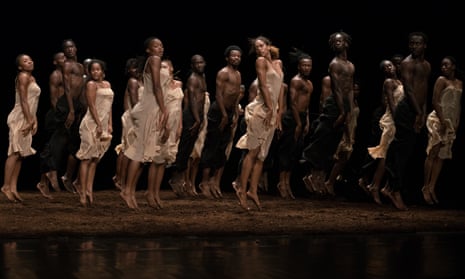‘How would you dance if you knew you were going to die?” was the question sparking Pina Bausch’s imagination when she created her shattering Rite of Spring in 1975. It grabs you by the throat from the first moment and never slackens.
This inspired staging was more than usually troubled. The Pina Bausch Foundation planned the piece with Senegal’s pioneering École des Sables, gathering 38 dancers from 14 different African countries, only for the pandemic to impose postponement. Now Covid reduces the cast and forces the cancellation of an accompanying duet, Common Ground[s], leaving us with a warmly received Q&A session to follow a Rite danced with such force you don’t feel short-changed.
Arrive early and you’ll see droves of fine peat poured on to the floor (Bausch didn’t want feet to be hobbled by claggy clay), forming the stark confines of this dramatic world. A woman lies face down on the ground. The day dawns into difficulty.
Bausch originally created the work for a Stravinsky triple bill. As the first thudding theme erupts, women rise and plunge, driving fists between their legs, pummelled by unrelenting rhythms. The choreography is continually unexpected yet feels gut-punchingly inevitable. This cast, a tight community assembled from scratch, is immersed in both wrenchingly abstracted and realistic movement. The women especially are tremendous in their discomfort: hands scratch at skin, uneasy glances are exchanged, they hurtle through flurries of soil in panic.
Bausch’s great theme was an irresistible antagonism between the sexes – here, bare-chested men dash with jackknife vigour between women shuddering uncontrollably in ivory slips (you’d swear you could hear their teeth rattle). A sacrificial dress stands out in livid red, like a wound passed from body to body until one woman emerges from the throng.
The answer to Bausch’s question is: you dance your death with excruciating commitment. Anique Ayiboe from Togo is electrifying as the sacrificial victim – grabbing at the air, revisiting earlier gestures with bigger, needier vehemence. Sweat-soaked, soil-spattered, she is left fearsomely exposed and exhausted until she collapses and releases us from this ferocious roar of a piece.
At Sadler’s Wells, London, until 11 June. Dancing at Dusk, a film about the production, is online on Sadler’s Wells Digital Stage from 9 June–9 July.

Comments (…)
Sign in or create your Guardian account to join the discussion